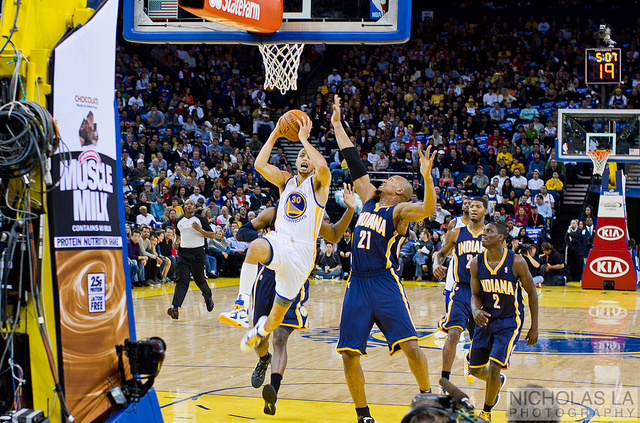The last day of the NBA regular season made for remarkable television. While Kobe Bryant, the first superstar to make his mark in the wake of basketball’s massive global expansion, was playing the final game of his illustrious twenty-year career in Los Angeles, the Golden State Warriors, the league’s best team and defending champions, were winning their record-breaking 73rd game.
As Bryant doggedly triumphed over the physical decline that had left him a shadow of his former self to rally his team to victory, presumptive Most Valuable Player Stephen Curry was capping off a season of unprecedented offensive efficiency with the aplomb that has made him a favorite worldwide. Switching back and forth between ESPN and ESPN 2 felt like getting a visitation from the Spirit of Basketball Past and the Spirit of Basketball Future simultaneously.
In the end, Bryant scored an astonishing 60 points, the most in the NBA all season, taking 50 shots, more than he ever had before in a career famous for what the statisticians call “high usage”. Curry, by contrast, netted 46 on only 24 shots, scoring his landmark 400th three-point shot along the way, then took most of the fourth quarter off. While both made for great theater, the contrast between their style of play couldn’t have been more clear.
Throughout this season, as the Warriors upped the ante on last year’s championship by winning their first 24 games and then staying on pace to beat the 72-10 regular-season record of Michael Jordan’s 1995-1996 Chicago Bulls team, they became popular in a way that few teams in any sport ever have. People who had rarely paid attention to the NBA in the past, even ones who weren’t entirely sure what the rules of basketball were, still watched highlights and read stories about how Golden State had turned the sport upside down by dominating their opponents the “wrong” way. Indeed, so many stories were published and broadcast about how Curry and his teammates were revolutionizing basketball that their exploits started to seem almost allegorical.
Because the team’s principal owner Joe Lacob is a Silicon Valley venture capitalist who does not shy from making brash pronouncements, the majority of these stories have depicted the Warriors as the sporting equivalent of a successful high-tech firm, which, as a recent profile in The New York Times put it, follows the same precepts of “nimble management, open communication, integrating the wisdom of outside advisers and continuous re-evaluation of what companies do and how they do it.”
Like other major sports, basketball has evolved in the past two decades from the province of former players who managed their teams according to an intuition grounded in real-world experience into one where only the most backward organizations still make decisions without the use of data analysis. The feedback loop between performance and analytics becomes more central each year, as tried-and-true notions are revealed to be founded more on fantasy than reality. At least, that’s the way that people like Joe Lacob like to think.
There was a time, not too long ago, when it was possible to push back against this rhetoric of “revolution” without being subject to ridicule. Whether you believed that traditional ways of playing still worked, despite the data being presented to the contrary, or simply asserted that “it’s just a game,” no matter how much money is being made, you could still maintain your credibility. More and more, though, these attitudes are denigrated as “dinosaur thinking.”
The problem with this trend is that it is inextricably bound up with a technologically inflected conception of progress that is almost perversely lacking in self-reflexivity. Just as high-tech billionaires like Microsoft’s Bill Gates, Facebook’s Mark Zuckerberg and Oracle’s Larry Ellison can’t seem to understand why anyone would resist their visions for remaking the world, the people who run teams like the Warriors and the journalists who sell their stories — because, let’s face it, those stories do sell — aren’t willing to admit the randomness factor in success. They truly believe that, if their team starts to win, as the long-suffering Warriors did, it must be because of how they reengineered the organization. And they are extremely confident that the progress they think they made in implementing these changes can be more or less permanent.
But that is the height of hubris. As the last several decades of political history have amply demonstrated, every gain made in the name of progress can be lost again, whether through bad luck or, more commonly, bad management. Looking at the United States or Western Europe in the 1960s, it would have seemed unfathomable that governments would end up doing so much less for their people today than they were doing back then. The state of California had perhaps the best university system in the world, with remarkably low fees and high performance, without in any way compromising its economy. Indeed, the reason Silicon Valley became Silicon Valley was largely because of the expansive educational opportunities that ensured an influx of brilliant young people who were not so burdened by debt that they were afraid to take risks.
This is not to take anything away from the Warriors’ achievement or the pleasure that they have given fans worldwide. The team’s daring style of play, typified by Stephen Curry’s incredible offensive performance, really does seem to conjure a future worth believing in. We would do well, however, to ask whether it needs to be conceived of in the way that Silicon Valley billionaires would like. What if the team’s success has as much to do with the fact that its players genuinely seem to have fun together than with the organization’s ability to exploit market inefficiencies? What if the biggest success on the business side were simply making the decision to pay what is necessary to keep these players together at a time when free agency and other financial restrictions are constantly threatening to undermine the solidarity that the best collaborative performance seems to require?
It make for a worthwhile thought experiment to reflect on sports teams, not from the perspective of those who seek to maximize profits, but those who seek to maximize joy. The reason why so many people follow sports is that they promote the sort of storytelling in which rational calculation can never quite explain everything that happens. That doesn’t mean that analytics should be shunted aside. It is perfectly possible to use data to tell better stories, rather than acting as though the goal is to transcend the need for them. The proliferation of media content about the Warriors’ remarkable season attests as much. But it’s crucial to remember that people aren’t reading and watching those stories because they want to be disenchanted.
Let’s return to the contrast between Kobe Bryant’s final game and Stephen Curry’s sure-to-be-MVP-capping performance. As much as Bryant is admired around the world, he has always been notorious for pursuing individual success even when a more team-oriented approach might have helped his team win more games. To be sure, he justified this “high usage” brand of basketball by asserting that he was being a role model for his teammates. If they would only work as hard as he did, care as much as he did, demand as much as he did, they would be bound to play better as a team. Unfortunately, though, in a sport where the specter of scarcity is never far away — there is only one basketball in play at a time — this individualist notion of internal competition only works if other players defer to the leader’s desire for mastery. That’s why so many of Bryant’s teammates over the years were eager to play elsewhere, despite the success they enjoyed with the Los Angeles Lakers.
What appeals to both diehard basketball lifers and casual fans alike about Stephen Curry is that, for all of his astonishing skills, he never seems to want to be like Kobe or, to quote the famous commercial about Mr. Air Jordan, be like Mike. He shoots less, passes more and spends a lot more time on the bench, typically, than either Bryant or Jordan did in their prime. His efficiency on the offensive end is a product of a willingness to spread the ball around and, with it, the joy. If the Warriors are succeeding as a team to an unprecedented degree, it may simply because they really do exemplify the team-first mentality that great players have always invoked but not always lived up to.
We don’t have to look to the Warriors to confirm the “revolutionary” logic of Silicon Valley. The vast amounts of data that tell us why and how they succeed on the basketball court don’t need to be thought of in a strictly business sense. Instead, we can regard this Golden State team as role models for a way of working together that prioritizes having fun at work. What if, in short, we prioritized the use of analytics, not as a measure of performance in the traditional corporate sense, like some postmodern cubing of Fredrick Winslow Taylor’s The Principles of Scientific Management, but as a measure of pleasure and the good it does for people when they collaborate on a task?
Photo courtesy of nikk_la, published under a Creative Commons License





